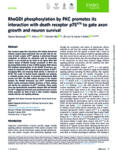In this new paper, we show how the GDNF receptor GFRα1 functions cell-autonomously in subpopulations of olfactory bulb interneuron precursors to regulate their generation and allocation in the mammalian olfactory bulb.
GFRα1, a receptor for glial cell line-derived neurotrophic factor (GDNF), is critical for the development of the main olfactory system. The olfactory bulb (OB) of Gfra1 knockout mice showed significant reductions in the number of olfactory sensory neurons, mitral and tufted cells, as well as all major classes of OB GABAergic interneurons. However, the latter did not express significant levels of GFRα1, leaving the mechanism of action of GFRα1 in OB interneuron development unexplained. We have found that GFRα1 is highly expressed in the precursor cells that give rise to all major classes of OB interneurons, but is downregulated as these neurons mature. Conditional ablation of GFRα1 in embryonic GABAergic cells recapitulated the cell losses observed in global Gfra1 knockouts at birth. GFRα1 was also required for the sustained generation and allocation of OB interneurons in adulthood. Conditional loss of GFRα1 altered the migratory behaviour of neuroblasts along the rostral migratory stream (RMS) as well as RMS glial tunnel formation. Together, these data indicate that GFRα1 functions cell-autonomously in subpopulations of OB interneuron precursors to regulate their generation and allocation in the mammalian OB.
The paper has just been published in Biology Open.
Read the full paper HERE.



Leave a Reply